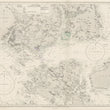

1936 / 1958 China Sea - Singapore Strait
DESCRIPTION
A large mid-century working nautical chart of the Singapore Strait, within the China Sea. Information used to produce this sea chart dates back to the mid-19th century and it was first published by the Admiralty in 1936 under Crown copyright with updates and small corrections to 1958.
The map centers on the town of Singapore and includes Johore, Pulau Batam, Pulau Bintam, and many other islands shown along the Singapore Strait. Depth soundings, navigational lights, and anchorage areas are noted throughout the map as well as a specific area in the middle of the strait designated as a dumping ground for ammunition. Roads, forts, government houses, a prison and other important buildings and inland locations are identified. Interestingly, physical topography is mapped, which is not common for nautical charts but makes sense as large landmarks can be a useful aid in navigation.
About the Singapore Strait in the 1950s
Singapore Strait is a vital maritime passage connecting the Indian Ocean and the South China Sea. It serves as a bustling thoroughfare for international shipping, facilitating trade between Europe, Asia, and Oceania. During the time this map was published, the strait was vulnerable to piracy and maritime security threats, prompting efforts to enhance surveillance and security measures. Overall, the Singapore Strait in the 1950s was a crucial maritime artery amidst the backdrop of post-World War II economic growth and geopolitical tensions in Southeast Asia.
Advancements in Nautical Chart Printing Technology
Traditionally, nautical charts issued by the Admiralty were meticulously crafted from copper plate engravings. However, the evolving nature of the real world posed challenges in updating these engravings. In the 1820s, attempts were made to explore lithography as an alternative, yet the results fell short of expectations despite its cost-effectiveness. Consequently, copper plate printing remained predominant well into the 20th century.
A significant turning point arrived in 1938 with trials of the rotary offset process, utilizing zinc plates replicated from the original copper engravings. The success of these trials led to the adoption of this faster and more sustainable process for all chart production by the outbreak of World War II. This innovation proved vital in meeting the heightened demand for charts during wartime.
Following the war, advancements in printing technology enabled the introduction of color printing with sufficient precision for charting purposes. The incorporation of printed color, rather than hand-drawn, revolutionized chart design. Notably, the first application of printed color was in delineating water depths Solid pale light green or blue was used for water to the 3 fathom line, and a ribbon of the same color was used six fathoms
This chart is a fine example of the breakthrough change in printing technology utilized for nautical charts during and after WWII.
CONDITION
1200 W. 35th Street #425 Chicago, IL 60609 | P: (312) 496 - 3622



